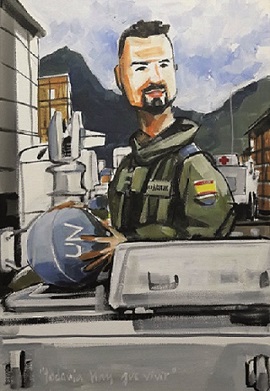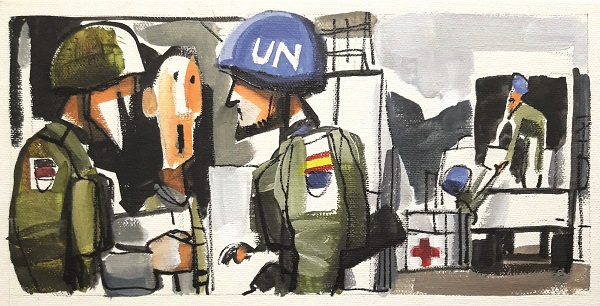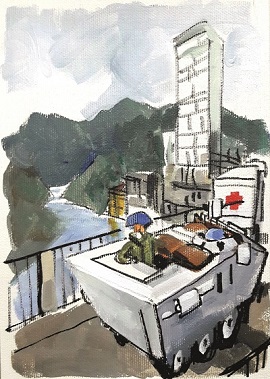Crossing Tito’s Bridge
Lieutenant Francisco Jesús Aguilar
1st Spanish Legion Tercio ‘Gran Capitan’
The Bosnian Croats have eventually agreed to hand in the medicines they keep at their hospital so they can be taken to the Mostar Muslim hospital, so badly needed by the wounded Bosnians. The talks have not been easy. They wanted journalists there. The image war also plays a role among the Bosnia-Herzegovina disasters. They have resigned themselves to the public information team the Spanish Ministry of Defence has deployed there to film the collection of medicines and the inside of the hospital.

The mission is not going to be easy. Grenades are pouring in everywhere. Some days even 2,000 have been counted. Gunfire is all around the streets of that which once was the beautiful city of bridges, and now has become the dark town of terror. Regiment ‘Canarias’ is aware of this, so they know they cannot take a rest.
The captain is at the vanguard, two armoured vehicles are at the centre, and closing the column, at that difficult point where you move looking back, lieutenant Francisco Jesús Aguilar’s vehicle. They cross the boulevard and reach the Croatian hospital in Eastern Mostar, where they take the medicines.
The hospital director keeps insisting that he wants international press to capture the moment.
The soldiers know that memory is on the streets, that there is too much dispersed dust caused by the explosions, and that they must take the irremediable way that will take them to cross Tito’s Bridge. The operational area of the Bosnian Croat Army has been informed about their intention to cross it, but they are living that moment when neither ceasefires nor hospitals are respected. They are certain that their column will receive fire from the buildings around them, that narrow the streets with the winding sound of shots and explosions.

Lieutenant Aguilar remains in his hatch, that covers his back. The column is only a few metres away from Tito’s Bridge, and the Neretva River can be felt underneath. The stone has been damaged badly, the smoke and dust saturate the air. The armoured targets under the UN flag walk their way towards the Muslim district as they move between the crossfire Muslims and Bosnian Croats open at Santice Street and at the square Spaniards call their own. ‘They know we’re on our way there, they know we’re UN peacekeeping forces, they know we’re taking medicines to the Muslim hospital, and still, they keep shooting’.

They have walked along this way before. However, it is not always the same. The vehicles break the beams of light that, like swords, cross the dust, lighting the sand that falls to the ground due to its own weight. All vehicles have been hit, both men and machines are being severely punished. Nevertheless, they resist, they know the mission comes first, and so do the wounded and ill people who are waiting for them at the Muslim Hospital in Eastern Mostar.
The vehicle drivers remain alert. The soldiers, inside the vehicles, do not see the dust coming from the explosions, or the narrow windows, or the walls that fester hate and are guided by smells and noises. They all stand firm in their way. The dividing line, Tito’s Bridge, is very close to them.
Lieutenant Aguilar remains firm in his position. He is in the rear, saving the back and flank of the column...
Lieutenant Aguilar remains firm in his position. He is in the rear, saving the back and flank of the column. He is not already aware that bravery is the everlasting memory. When, suddenly, a Croatian shot crosses his shoulder, scraping against his marrow, at that point, he gloriously burns (paraphrasing Quevedo’s sonnet) and falls down dead over the hatch. They cross Tito’s Bridge as the convoy arrives to the Muslim hospital at Mostar with the medicines, to save lives, which was precisely their mission on that 11 June 1993.
ARMY UNITS
- Araba Álava |
- Albacete |
- Alicante |
- Almería |
- Asturias |
- Ávila |
- Badajoz |
- Barcelona |
- Burgos |
- Cáceres |
- Cádiz |
- Cantabria |
- Castellón |
- Ceuta |
- Ciudad Real |
- Córdoba |
- A Coruña |
- Cuenca |
- Girona |
- Granada |
- Guadalajara |
- Gipuzkoa |
- Huelva |
- Huesca |
- Islas Baleares |
- Jaén |
- León |
- Lleida |
- Lugo |
- Madrid |
- Málaga |
- Melilla |
- Murcia |
- Navarra |
- Ourense |
- Palencia |
- Las Palmas |
- Pontevedra |
- La Rioja |
- Salamanca |
- Segovia |
- Sevilla |
- Soria |
- Tarragona |
- Santa Cruz de Tenerife |
- Teruel |
- Toledo |
- Valencia |
- Valladolid |
- Bizkaia |
- Zamora |
- Zaragoza



